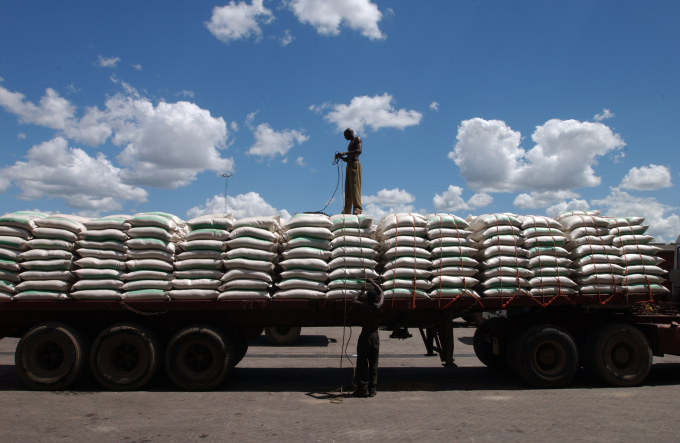June 5, 2025 | 05:03 GMT +7
June 5, 2025 | 05:03 GMT +7
Hotline: 0913.378.918
June 5, 2025 | 05:03 GMT +7
Hotline: 0913.378.918

Loading grains in Tanzania. Photo: Giuseppe Bizzarri/FAO
World food commodity prices made a significant leap in March to reach their highest levels ever, as war in the Black Sea region spread shocks through markets for staple grains and vegetable oils, the Food and Agriculture Organization of the United Nations (FAO) reported today.
The FAO Food Price Index averaged 159.3 points in March, up 12.6 percent from February when it had already reached its highest level since its inception in 1990. The Index tracks monthly changes in the international prices of a basket of commonly-traded food commodities. The latest level of the index was 33.6 percent higher than in March 2021.
The FAO Cereal Price Index was 17.1 percent higher in March than in February, driven by large rises in wheat and all coarse grain prices largely as a result of the war in Ukraine. The Russian Federation and Ukraine, combined, accounted for around 30 percent and 20 percent of global wheat and maize exports, respectively, over the past three years. World wheat prices soared by 19.7 percent during the month, exacerbated by concerns over crop conditions in the United States of America. Meanwhile, maize prices posted a 19.1 percent month-on-month increase, hitting a record high along with those of barley and sorghum. Contrasting trends across the various origins and qualities kept the March value of FAO’s Rice Price Index little changed from February, and thus still 10 percent below its level of a year earlier.
The FAO Vegetable Oil Price Index rose 23.2 percent, driven by higher quotations for sunflower seed oil, of which Ukraine is the world’s leading exporter. Palm, soy and rapeseed oil prices also rose markedly as a result of the higher sunflower seed oil prices and the rising crude oil prices, with soy oil prices further underpinned by concerns over reduced exports by South America.
The FAO Sugar Price Index rose 6.7 percent from February, reversing recent declines to reach a level more than 20 percent higher than in March 2021. Higher crude oil prices were a driving factor, along with currency appreciation of the Brazilian Real, while favorable production prospects in India prevented larger monthly price increases.
The FAO Meat Price Index increased by 4.8 percent in March to reach an all-time high, led by surging pig meat prices related to a shortfall of slaughter pigs in Western Europe. International poultry prices also firmed in step with reduced supplies from leading exporting countries following avian flu outbreaks.
The FAO Dairy Price Index rose 2.6 percent and was 23.6 percent higher than in March 2021, as quotations for butter and milk powders rose steeply amid a surge in import demand for near and long-term deliveries, especially from Asian markets.
Further details are available here.
Updated forecasts for cereals
FAO also released its new Cereal Supply and Demand Brief, which includes a forecast for global wheat production in 2022 of 784 million tonnes, a 1.1 percent increase from 2021. That estimate factors in expectations that at least 20 percent of Ukraine’s planted area to winter crops, notably winter wheat, may not be harvested due to direct destruction, constrained access or a lack of resources to harvest crops, reports from Russia of continued conducive weather conditions, as well as prospective production trends in China, the European Union, India, North America and elsewhere. Coarse grain production prospects remain favorable in Argentina, Brazil and South Africa.
Wrapping up the 2021 crop year, FAO’s estimate points to a worldwide cereal production of 2 799 million tonnes, up slightly from 2020, with rice production reaching an all-time high of 520.3 million tonnes (in milled equivalent).
Global cereal utilization in 2021/22 is projected at 2 789 million tonnes, including a record level for rice, with increases also expected for maize and wheat.
Global cereal stocks ending in 2022 are forecast to rise by 2.4 percent from their opening levels, largely due to higher wheat and maize stocks in Russia and Ukraine on account of lower expected exports. The global cereal stocks-to-use ratio is forecast at 29.7 percent in 2021/22, only marginally below the previous year and “still indicating a relatively comfortable supply level,” according to FAO.
FAO lowered its forecast for world trade in cereals in the current marketing year to 469 million tonnes, marking a contraction from the 2020/21 level, largely due to the war in Ukraine and based on currently available information. Expectations point to the European Union and India increasing wheat exports, while Argentina, India and the U.S. shipping more maize, partially compensating for the loss of exports from the Black Sea region.
(FAO.org)

(VAN) Vikas Rambal has quietly built a $5 billion business empire in manufacturing, property and solar, and catapulted onto the Rich List.

(VAN) Available cropland now at less than five percent, according to latest geospatial assessment from FAO and UNOSAT.

(VAN) Alt Carbon has raised $12 million in a seed round as it plans to scale its carbon dioxide removal work in the South Asian nation.

(VAN) Attempts to bring down the price of the Japanese staple have had little effect amid a cost-of-living crisis.

(VAN) Fourth most important food crop in peril as Latin America and Caribbean suffer from slow-onset climate disaster.

(VAN) Shifting market dynamics and the noise around new legislation has propelled Trouw Nutrition’s research around early life nutrition in poultry. Today, it continues to be a key area of research.

(VAN) India is concerned about its food security and the livelihoods of its farmers if more US food imports are allowed.